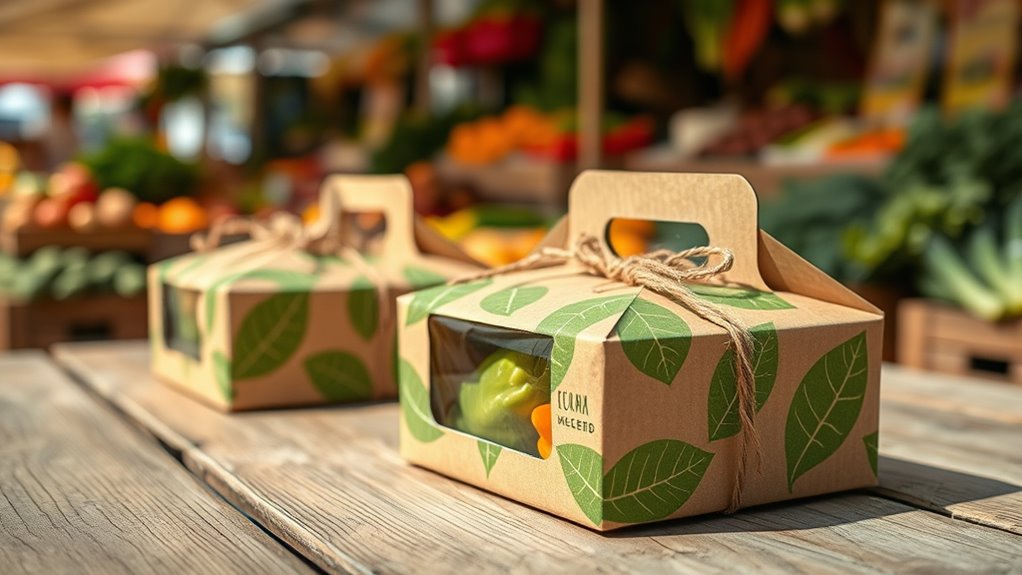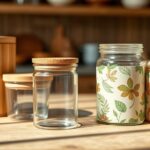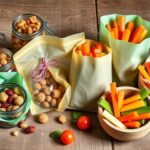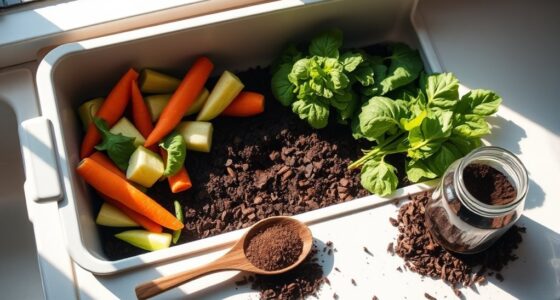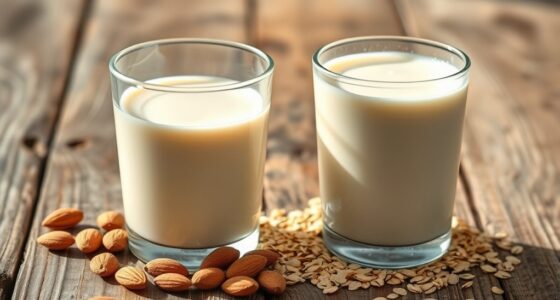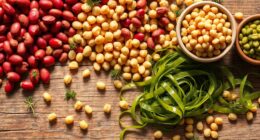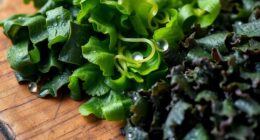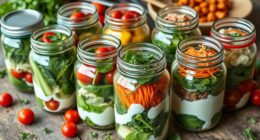Innovations in sustainable food packaging focus on using biodegradable materials that break down naturally without harmful residues, offering eco-friendly alternatives to plastics. You’ll see cleaner manufacturing methods that cut energy use and emissions, often using renewable resources. New technologies like plant-based plastics and agricultural waste turn waste into valuable packaging. Fully compostable options support a circular economy, and AI security enhances trust and safety. Keep going to explore how these innovations are shaping a greener future.
Key Takeaways
- Development of biodegradable and compostable packaging materials derived from renewable resources like plant-based plastics and agricultural waste.
- Adoption of eco-friendly manufacturing processes that reduce energy consumption, emissions, and chemical use.
- Integration of innovative coatings that are moisture and gas resistant, ensuring food freshness while maintaining sustainability.
- Creation of fully circular packaging solutions designed for home or industrial composting, supporting a circular economy.
- Utilization of AI security and technology to enhance supply chain transparency, safety, and consumer trust in sustainable packaging.
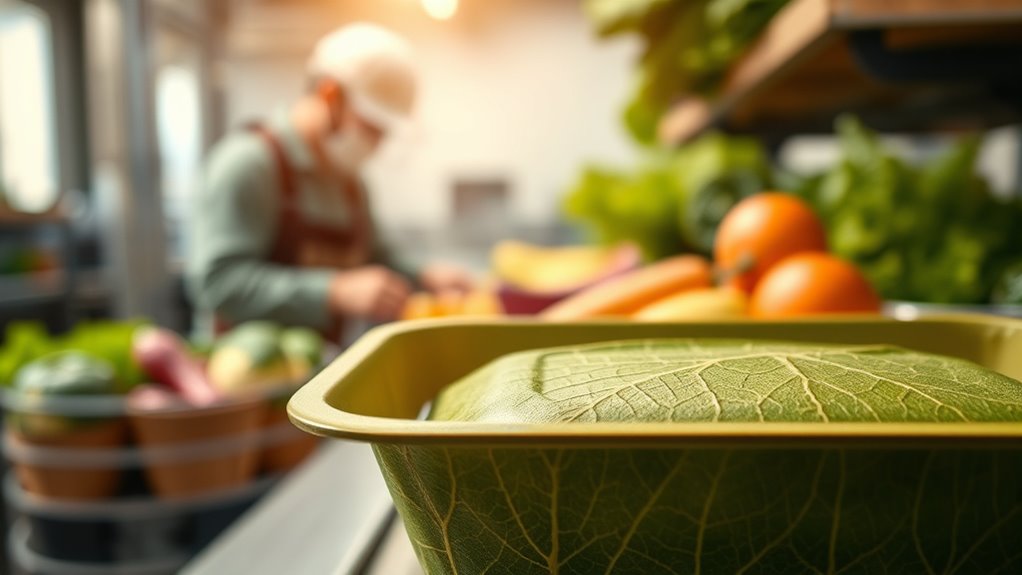
Have you ever wondered how the packaging of your favorite foods impacts the environment? Every time you pick up a snack or a bottle, you’re indirectly supporting a system that can either harm or help our planet. Innovations in sustainable food packaging are making it easier for you to make eco-friendly choices. One of the most promising developments is the increased use of biodegradable materials. These materials break down naturally in the environment, reducing landfill waste and pollution. Unlike traditional plastics, biodegradable options are designed to decompose within a reasonable timeframe, leaving behind no toxic residues. This shift is driven by a growing awareness of the environmental toll of conventional packaging and a desire to minimize your carbon footprint.
Eco-friendly manufacturing processes are also playing a vital role in transforming the packaging industry. Manufacturers are now adopting cleaner production methods that reduce energy consumption, cut down on emissions, and avoid harmful chemicals. By using renewable energy sources and implementing efficient techniques, companies are making their packaging more sustainable from the ground up. This means that the packaging you encounter on grocery shelves is increasingly being produced with eco-conscious principles, making it easier for you to support brands that prioritize environmental responsibility.
You might notice that some packaging now features plant-based plastics or materials derived from agricultural waste. These innovations not only decrease reliance on fossil fuels but also promote the circular economy by utilizing renewable resources. In addition, advances in coating technologies have led to packaging that’s both biodegradable and resistant to moisture and gases, ensuring food stays fresh without compromising sustainability. Such innovations make it possible for you to enjoy your favorite products without guilt, knowing the packaging aligns with your eco-friendly values.
Furthermore, companies are investing in research to develop fully compostable packaging solutions that can be returned to the earth safely. This progress means that after you’ve finished using the product, the packaging can be composted at home or industrial facilities, closing the loop in a truly sustainable cycle. These efforts are part of a broader movement toward transparency and accountability, encouraging you to choose products with packaging that’s designed to lessen environmental impact. Additionally, integrating AI Security technologies helps ensure the integrity and safety of supply chains involved in sustainable packaging, promoting trust and reliability in eco-friendly products.
Frequently Asked Questions
How Do Sustainable Packaging Materials Impact Food Shelf Life?
Sustainable packaging materials can positively impact food shelf life by maintaining freshness and reducing spoilage. Their improved material durability guarantees that food stays protected from external elements, which helps extend shelf life. Plus, using eco-friendly materials minimizes environmental impact and aligns with sustainable practices. You’ll find that these innovations not only preserve food quality longer but also support your efforts to reduce waste and promote environmental responsibility.
Are Biodegradable Packaging Options Cost-Effective for Large-Scale Producers?
Biodegradable packaging options can be cost-effective for large-scale producers when you compare costs and consider supply chain benefits. While initial expenses may be higher, long-term savings arise from reduced waste disposal costs and improved brand reputation. Additionally, a streamlined supply chain benefits from eco-friendly materials, making the overall cost comparison favorable. As a result, investing in biodegradable packaging can boost sustainability efforts without markedly increasing expenses.
What Are the Challenges in Recycling Innovative Food Packaging?
You face challenges in recycling innovative food packaging due to limited recycling infrastructure and contamination issues. Many facilities aren’t equipped to handle new materials, causing delays and waste. Contamination from food residues further complicates recycling processes, leading to higher rejection rates. To overcome these hurdles, you need better infrastructure, clear labeling, and public awareness to guarantee proper disposal. Addressing these issues helps make sustainable packaging truly effective and environmentally friendly.
How Do Consumer Preferences Influence Sustainable Packaging Development?
Imagine you’re steering a ship through a vast ocean of consumer trends, where each wave of eco-conscious choices shapes the future. Your preferences act as a compass, guiding sustainable packaging development. When you favor eco-friendly options, companies respond by innovating with biodegradable materials and minimal waste designs. Your commitment to sustainability fuels this journey, ensuring that packaging evolves to meet your values and expectations, creating a greener, more responsible world.
What Regulatory Standards Govern Sustainable Food Packaging Practices?
You need to understand that regulatory standards govern sustainable food packaging practices through strict compliance and certification standards. You must guarantee your packaging meets regulatory compliance requirements set by organizations like the FDA, EPA, and EU regulations. Certification standards such as FSC, LEED, and Green Seal verify eco-friendly practices. Staying updated on these standards helps you develop packaging that’s legally compliant, environmentally responsible, and trusted by consumers.
Conclusion
As you embrace innovative packaging, imagine each eco-friendly wrapper as a seed planted in a greener world. Your choices become the roots that strengthen sustainability, while the packaging itself transforms into a shield, protecting both food and the planet. Every mindful decision is a ripple, sending waves of hope across oceans and forests. Together, your actions symbolize a future where harmony between nature and nourishment blossoms, turning small steps into a flourishing garden of change.
Ilana has been a vegan for over 10 years. She originally made the switch for health reasons, but soon found herself becoming more and more passionate about the ethical and environmental implications of a vegan lifestyle. Ilana is the author of The Graceful Kitchen, a blog all about veganism. She loves to cook up delicious and nutritious vegan meals, and share her recipes with others who are interested in leading a cruelty-free life. Ilana is also a strong advocate for using whole foods as the foundation of a healthy diet, and believes that going vegan is one of the best ways to achieve this.
